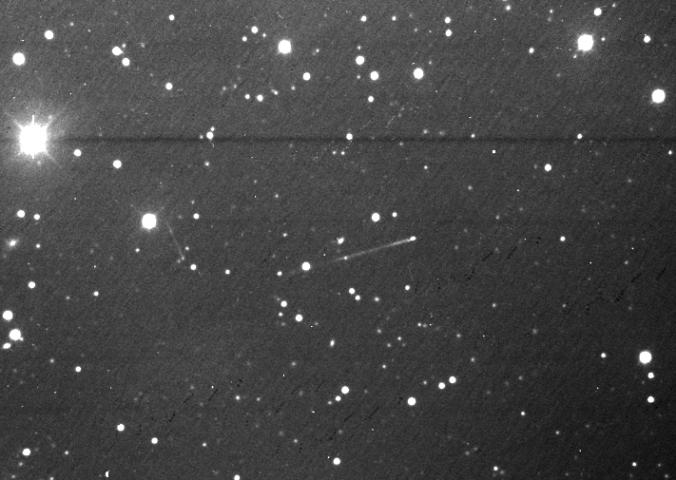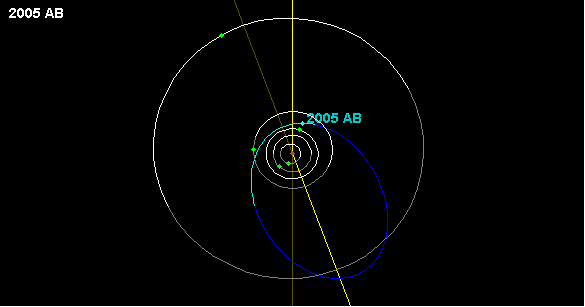| 2005 AB: New Binary NEA |
 |
| Related Websites Ron Dyvig's Badlands Observatory Dr Petr Pravec's Binary NEA Photometry Program JPL Orbit Simulation Page Minor Planet Center Spaceguard India |
| Near Earth Asteroid 2005 AB seen as a bright streak in the middle of this CCD image taken on the night of 5th February, 2005, from Badlands Observatory, South Dakota. |
| IAU Discovery Circular |
| Central Bureau for Astronomical Telegrams INTERNATIONAL ASTRONOMICAL UNION Mailstop 18, Smithsonian Astrophysical Observatory, Cambridge, MA 02138, U.S.A. [email protected] or FAX 617-495-7231 (subscriptions) [email protected] (science) URL http://cfa-www.harvard.edu/iau/cbat.html ISSN 0081-0304 Phone 617-495-7440/7244/7444 (for emergency use only) 2005 AB V. Reddy, Department of Space Studies, University of North Dakota, Grand Forks; R. Dyvig, Quinn, SD; and P. Pravec and P. Kusnirak, Ondrejov Observatory, report that photometric observations obtained during Feb. 1-8 show that the Amor-type minor planet 2005 AB (cf. MPEC 2005-A05, 2005-C48) is a binary system with orbital period 17.9 hr. The primary rotates with a period of 3.337 hr, and its lightcurve amplitude of 0.04 mag is indicative of a nearly spheroidal shape. Mutual events 0.06-0.11 mag deep indicate a secondary-to-primary mean-diameter ratio of 0.24 or greater. Further observations (especially radar and spectroscopic) are desirable. (C) Copyright 2005 CBAT 2005 February 11 (8483) Daniel W. E. Green |
| UND Press Release |
| UND GRADUATE STUDENT HELPS DISCOVER NEW BINARY NEAR-EARTH ASTEROID |
| Vishnu Reddy, a Master�s degree student at the University of North Dakota�s Department of Space Studies, has determined that a recently discovered near-Earth asteroid (NEA), 2005 AB, is a binary object that is actually composed of two asteroids. The announcement was made on February 11, 2005, in a circular issued by the International Astronomical Union. This is the 23rd discovery of a binary NEA out of the ~3200 currently known NEAs. Reddy, remotely using a 26-inch telescope and imaging camera at the Badlands Observatory in South Dakota, measured the reflected light from the asteroids from February 1-8, 2005, to determine the rotation period of the primary asteroid, which is 3.337 hours. He collaborated with Mr Ron Dyvig, an amateur astronomer who owns the facility. Observations to confirm this discovery were made by Dr Petr Pravec and Peter Krusnirak at the Ondrejov Observatory in the Czech Republic. The derived light curve also shows that the secondary asteroid orbits the primary every 17.9 hours. Binary asteroids are relatively recent discoveries and may provide crucial new insights into these asteroids and their dynamical and collisional evolution. Binary asteroids are also important from an impact hazard point-of-view: if a binary asteroid is on a collision course with Earth, new strategies must be developed to attempt to divert two objects instead of one. It has been estimated that as many as ~20% of the NEA population may include binaries. Reddy is also an experienced asteroid hunter, who has discovered 17 asteroids. He is currently finishing his Master�s thesis in the Department of Space Studies, which involves near-infrared spectral observations and interpretations of two olivine-rich asteroids, 246 Asporina and 446 Aeternitas. He will be presenting these results at the 36th annual Lunar and Planetary Science Conference (LPSC) that will be held in Houston during the week of March 12. |
 |
| Lightcurve of NEA 2005 AB showing the change in brightness due to its binary nature. Observations for this data were made from Badlands Observatory, South Dakota, and Ondrejov Observatory, Czech Republic. |
| Orbit of 2005 AB |
 |